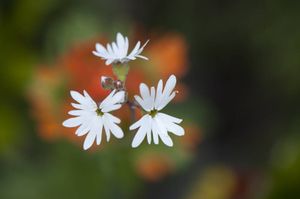Difference between revisions of "Lithophragma parviflorum"
(→Resources) |
|||
| Line 79: | Line 79: | ||
===Resources=== | ===Resources=== | ||
| − | |||
Revision as of 21:26, 20 March 2021
- Scientific Name: Lithophragma parviflorum
- Family: Saxifragaceae
- Common Names: small-flowered prairie star, small-flowered woodland star
- Synonyms/Misapplications: Lithophragma parviflora, Tellima parviflora
- Codon: LITPAR
Contents
Taxonomy
| Scientific classification | |
|---|---|
| Kingdom: | Plantae |
| Subkingdom: | Viridiplantae |
| Phylum: | Tracheophyta |
| Subphylum: | Spermatophytina |
| Class: | Magnoliopsida |
| Subclass: | Saxifraganae |
| Order: | Saxifragales |
| Family: | Saxifragaceae |
| Genus: | Lithophragma (Nutt.) Torr & A. Gray |
| Species: | Lithophragma parviflorum (Hook.) Nutt. |
Description
Perennial herbs from rhizomes with small bulblets, densely hairy throughout.[2]
Overall leaf shape orbicular to reniform, leaves 3-5 times palmately divided nearly to the base, then again lobed 2-3 times.[2]
Inflorescence a raceme, corolla consisting of 5 petals, which are generally 3-lobed. Calyx at anthesis is vase-shaped, ovary at least 2/3 inferior. Stamens 10. Stigmas have a narrow ring of hair just below tip.[3]
Plants along the coast in Washington and Oregon appear to have distinctly purple- and pink-tinged petals.[4]
3-beaked capsule, bearing seeds which are smooth or slightly wrinkled to reticulate, but never with prickles.[3]
Bloom Period
April-June.[5]
Distribution
BC southward, on both sides of Cascades, to northern California, east to Alberta, the Dakotas, and Colorado.[3]
Habitat
Prairies, balds, grasslands, sagebrush desert, and open forest, sea level to mid-elevations.[5]
Propagation
Seeds should be planted in late summer or fall following their collection. Long term seed storage is not recommended. Can be grown by seed or bulblet. Plants go dormant immediately after seed matures. No stratification processes are needed.[6]
Seed
Seed sample from: 2010
Average Measurement: 0.5 x 0.3 x 0.2
Measurement Range: L: 0.3 - 0.6, W: 0.1 - 0.3, D: 0.1 - 0.6
Features
Shape: Seeds very small, hilum puckered, and located at tapered end of seed. Opposite apex also tapered.
Color: Seeds dark brown, and almost black at ridges and wrinkles.
Surface: Seeds have at least one major ridge that extends longitudinally from hilum to opposite apex. Seeds may have some other longitudinal ridging and wrinkling. Seeds very shiny, smooth, and iridescent.
Latitudinal Cross Section: elliptical 
Longitudinal Cross Section: elliptical 
Photo Gallery
Resources
- ↑ Integrated Taxonomic Information System. Retrieved from https://www.itis.gov/servlet/SingleRpt/SingleRpt?search_topic=TSN&search_value=24398
- ↑ 2.0 2.1 Klinkenberg, Brian. (Editor) 2020. E-Flora BC: Electronic Atlas of the Plants of British Columbia [eflora.bc.ca]. Lab for Advanced Spatial Analysis, Department of Geography, University of British Columbia, Vancouver. [Accessed: 2020-06-08 12:03:17 PM ]
- ↑ 3.0 3.1 3.2 Hitchcock, C. L., Cronquist, A., Giblin, D., & Legler, B. et al. (2018). Flora of the Pacific Northwest: an illustrated manual. Seattle: University of Washington Press.
- ↑ Starflower Habitat Education Activities and Resources. Washington Native Plant Society. https://www.wnps.org/starflower#landscape.
- ↑ 5.0 5.1 WTU Herbarium, Burke Museum, & University of Washington. Retrieved from https://biology.burke.washington.edu/herbarium/imagecollection/taxon.php?Taxon=Lithophragma%20parviflorum
- ↑ Flora-Tostado, M. (2010, May 21). Plant Propagation Protocol for Lithophragma parviflorum. UW Courses: ESRM 412 – Native Plant Production.



